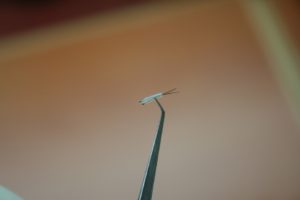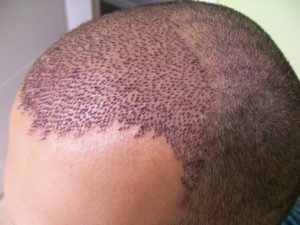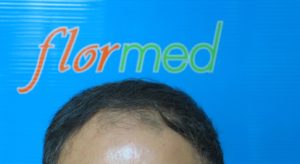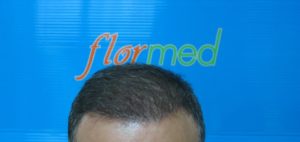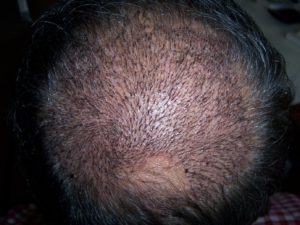The early practices of surgical hair transplant were actually cultivated in Japan in the late 1930s, by a Japanese doctor Okuda, and especially from the last decade on hair transplant has become widespread in Turkey as well as in other parts of the world. In the “punch technique”, follicular units (FU) were collected from the hair-bearing skin using special cylindrical punch blades.
Unlike the ones in the 1930, the punches today are smaller in size as well as outer and inner diameters and more precise. Moreover, compared to the experimental transplants in the 1930s, the number of grafts harvested per session has increased unprecedentedly.
HAIRLINES AND THE DETERMINATION OF THE TRANSPLANT AREA
Each person’s hair is unique. The doctor’s experience, the age and the anatomical characteristic of the client, the scale and the nature of the hair loss have much to do with shaping the hairline.
In order not to be misled, hairline and the donating part are determined prior to hair cut off.
DETERMINATION OF THE AREA TO BE TRANSPLANTED
This practice which is ignored by many hair transplant centres is essential to minimize the chances of mistakes that are likely to occur due to the differences in head shapes.
By doing this, the number of roots is almost precisely calculated and the chances of unwanted situations such as excessive follicular unit extraction or insufficiency of follicular units at the end of the operation are minimized. A 5-6 minute work using a stretch film, graph paper and a pen is enough for this.
The area to be transplanted is copied, and using graph paper, its size is measured in square centimetres. After the determination of hairline and the area to be transplanted and measurement of minimum follicular units, the hair is completely trimmed.
Following the local anaesthesia, the area is cleaned using antiseptic solutions and follicular unit gathering starts.
The gathering process is usually carried out in a facedown position and it might take from 1 to 3 hours.
Depending on the needs, hair density in the donating area, technical capacity of the team, 4500 or 5000 FU can be amounted using the FUE technique. This number is valid for optimum conditions because even if the team is well-qualified and have sufficient technical capacity, if the donating area has limited donor supply, the abovementioned number is not achievable.
If the person has a big bold spot (Norwood VI-VII / if there is hair loss both in the top and front parts) and the number of required follicular units exceeds 4500, the transplant is usually carried out in two sessions considering the technical capacity and the health status of the person. Because operations exceeding 3500 FU are unpleasant as well as time-consuming both for the patient and the team.
Despite all these, for many of the hair loss cases and patterns, 2500-3000 units might suffice for each session.
The FUE may not be an appropriate technique for those who have curly (as in Black people’s hair) or thin hair. Despite the introduction of special punch blades, the FUT technique might be a better option for these people.
Follicular units cut and harvested through the FUE punch and spots that will be covered by hair soon
The harvested units are stored in special storage solutions. Until the transplant period, the extracted units can be stored in a petri dish at 4°C ringer lactate, SF or special solutions. Any delay in the storage period might result in a failure in hair transplant operation. Therefore, the units should be transplanted as soon as possible.
 Units stored in special solutions in petri dish
Units stored in special solutions in petri dish
OPENING OF HAIR CHANNELS
A channel is opened depending on the size of the area to be transplanted. To achieve this, finely-cut chisel blades and handles are used. Prior to this practice, a local ansthesia is administered by cleaning the area using antiseptic solutions.
0,1 precision chisel blades of different sizes (channel blades)(0,6-1,3 mm)
Blades of different sorts which ensure root channel treatment and the direction of channel roots
Positioning the blade handles at the root depth prevents the pulling of the roots into the depth.
HAIR TRANSPLANT
Sharp-edged pensets called jeweler forceps are used for this practice. The roots stored in petri dishes are placed on the channels which have been opened using special pensets. The placement process is usually carried out by healthcare staff or nurses.
However, hair line, transplant to the crown and temporal parts, where hair direction is of crucial importance, should be carried out by the doctor himself/herself or the most experienced healthcare staff.
Transplant process might range from 1 hour to 4 hours depending on the previous experience of the team, skin type and root morphology of the client, and it could turn out to be quite difficult because of poping. Considering the possibility of poping, it is recommended to be reasonable with the root units to be extracted because poping cannot be predicted.
In many instances of hair transplant, 2500-3000 units might suffice for the front or top of the head. In case of any excess in the number recommended above, the operation might take longer and some people who have insufficient blood circulation in the scalp might suffer from poor hair growth. Unless otherwise is necessary, keeping the number at this rate might facilitate hair transplant surgery and promote the comfort of the operation.
After the transplant, the operation is over. The following day and the following week, there will be some incrustation on the transplanted area.
All the incrustation will clear within 15 days utmost and the implanted roots will start to grow. Almost all hair will fall off within a month. The falling part is not the roots, but the keratin in the hair because the roots are strong and live.
The transplanted hair experiences a telogen phase of 2-3 months in which there is a resting state. This is called shock loss, and is temporary because there starts the anagen phase in the following 2-3 months and the hair starts to come out.
Incrustation two days after the transplant
The fall of hair during the hair wash in the first week after the implantation is called shock loss. The most important characteristic of this loss is that there are no surgical complications such as bleeding, pain or discomfort.
The real follicular loss is a bleeding one and occurs especially within three days after some sort of disturbance or a strong hair wash. Therefore, caution should be exercised especially 4 or 5 days after the transplant. A gentle wash, rubbing after drying and avoidance of any disturbance are recommended. In this way, hair loss can be minimized. In a nutshell, if hair fall does not include bleeding, root loss does not occur.
Incrustation after vertex transplant
HAIR GROWTH
It might take 2-3 months for the transplanted hair to come out while a one-year period is necessary for the whole hair growth and thickening.
However, sometimes the whole hair growth might range from 4 months to 16 months.
To draw a generalization, it could be stated that a 8-10 month period might be enough for the hair to reach almost its final appearance.
There is little possibility for the transplanted hair to become weak, fall out or fail growth.
Regrowth of hair after 2 months
Prior to transplant
The hair line alternatives are considered and negotiated with the person.
The negotiated hair line is completed and the hair is cut off.
6 months after transplant
ASSIMETRICAL DISTRIBUTION OF HAIR LINE AND NATURAL OUTCOMES
VERTEX AREA
Pre-transplant planning
Hair transplant is just over
Incrustation following the transplant (The following day)
The hair in its natural direction after a year
WARNING!!! In many cases, the vertex area, unlike the frontal area, requires a second densification session for a dense appearance.
 Please pay attention to the natural appearance of the hair direction in the crown area after transplant.
Please pay attention to the natural appearance of the hair direction in the crown area after transplant.
Opening and transplanting channels in a natural direction on the vertex area requires considerable attention and precision, which makes the process demanding; therefore, a further session is devoted to vertex transplant.
Since this practice takes too much time, many centres do not pay due attention (especially when the front and top parts of the head are transplanted). As a result, the hair which does not grow in the natural direction does not look dense enough. Thus, due attention should be paid to vertex transplant, and, unless necessary, concurrent transplant with the frontal area should be avoided.


















